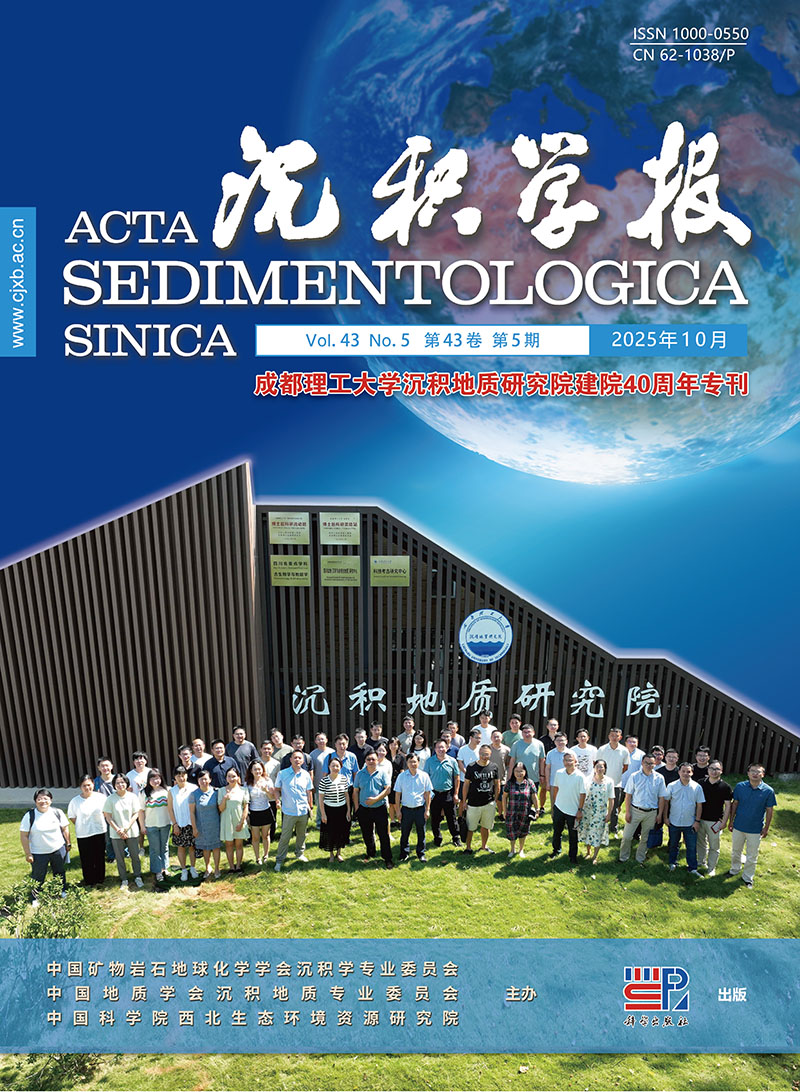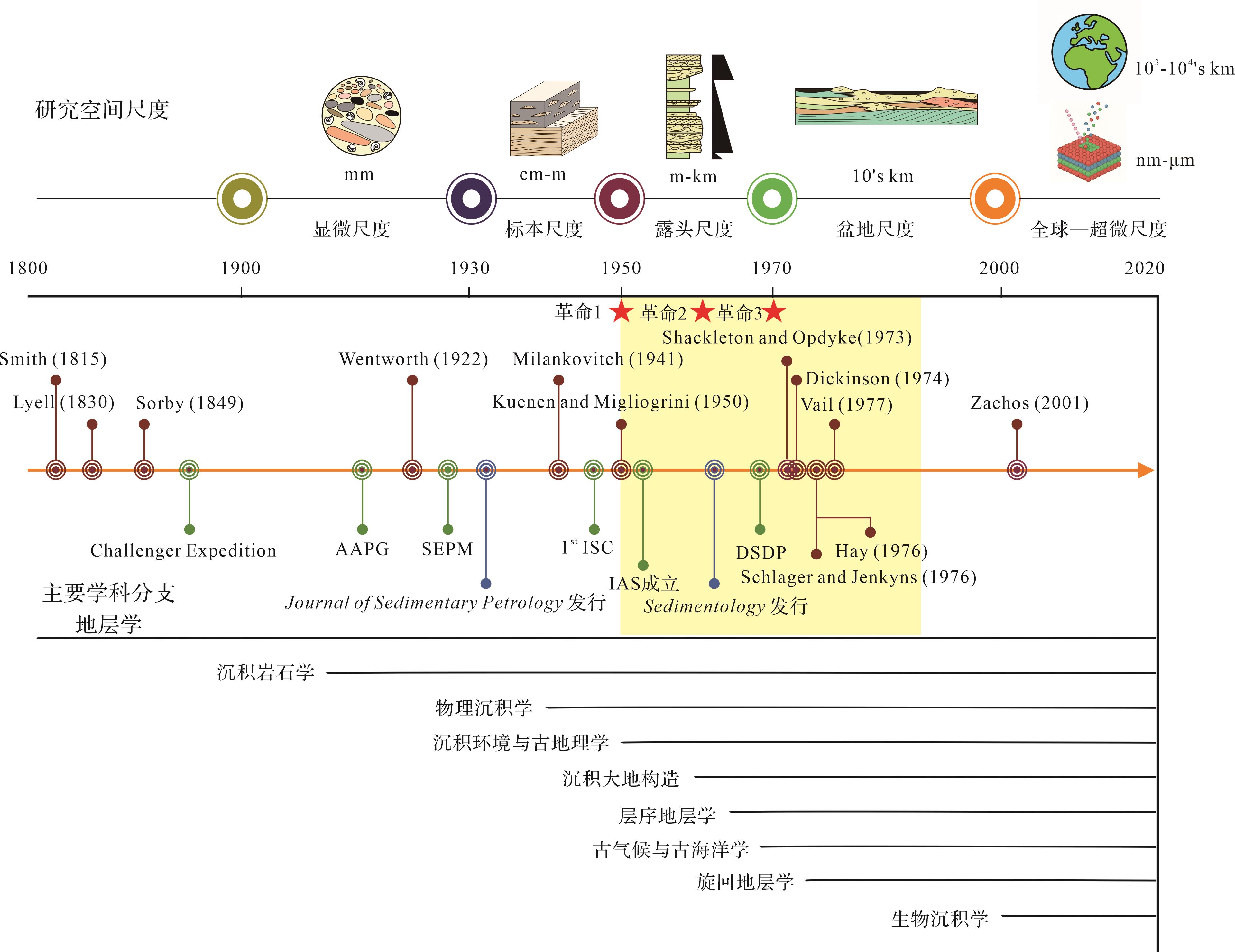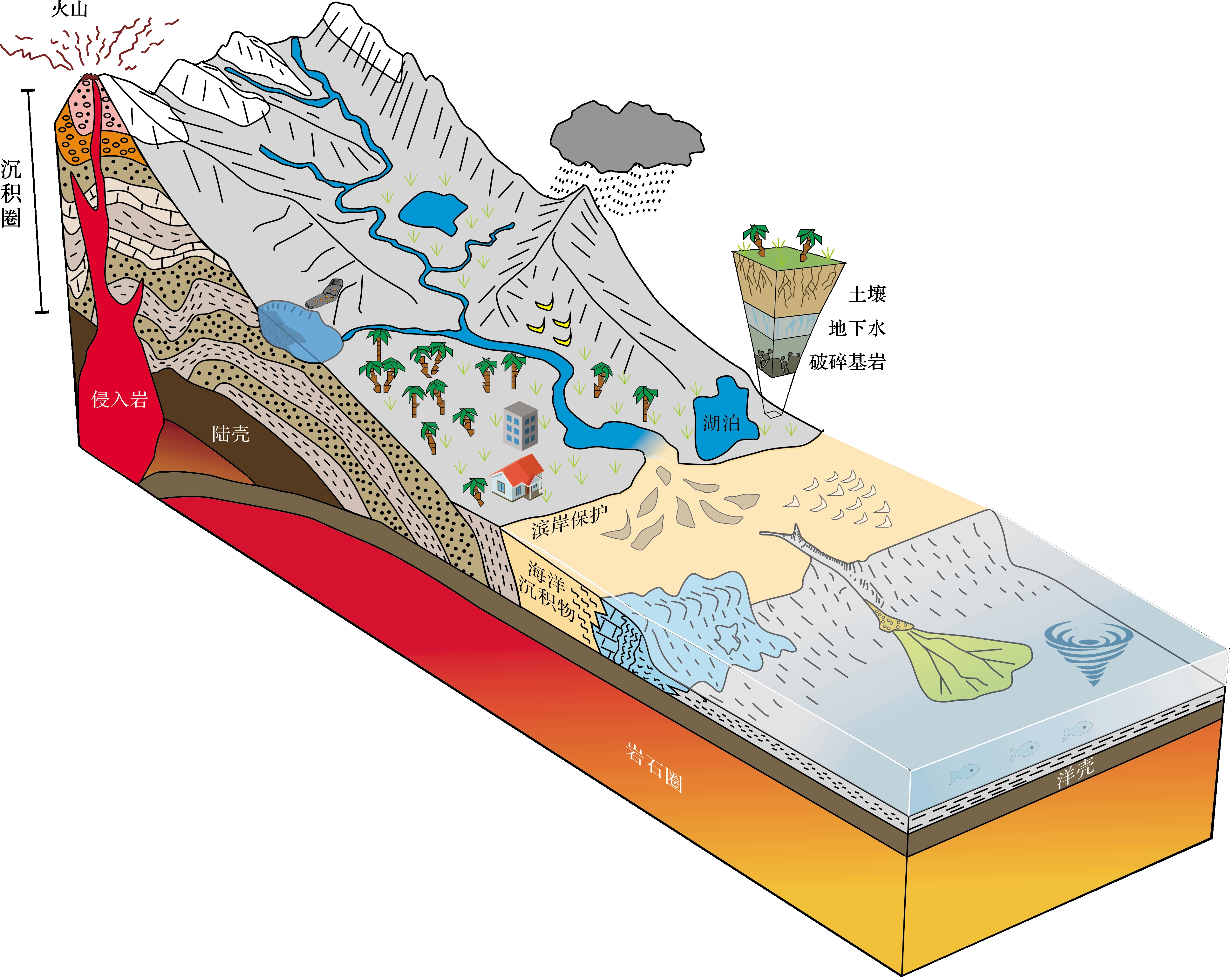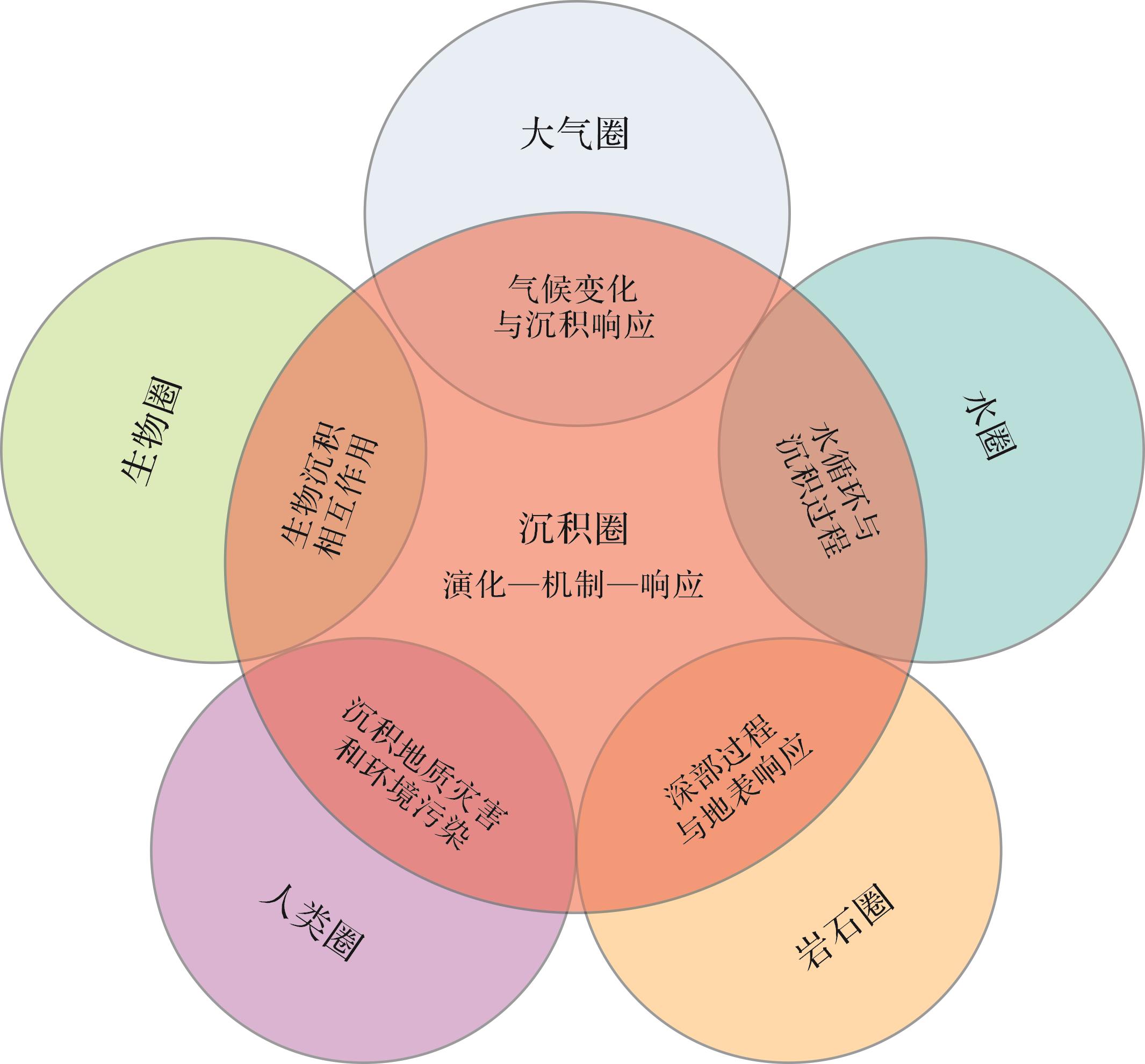HTML
-
现今地球表层大部分区域被沉积岩(物)所覆盖,这类岩石不仅蕴含着丰富的能源矿产,还忠实地记录着地球的演化历史。作为一门研究沉积岩(物)的学科,沉积学内涵从早期的岩石学客观描述,到沉积过程和沉积环境分析,再扩展至地表圈层活动[1]。随着研究维度的不断拓展和其他学科体系的深度融合,沉积学已成为当代地球科学中研究领域最广泛的基础学科之一[2⁃6]。
沉积学作为独立学科体系的构建始于19世纪末至20世纪初,在理解地球演化历史、解决能源和水资源短缺、生态和环境污染、地质灾害问题,以及实现人类可持续发展等方面,均具有深远的学科意义和重大的战略价值[7]。沉积学在过去百年间的发展有何规律?其发展与社会需求之间存在怎样的关联?未来又将朝着哪些方向演进?为探讨上述问题,本文通过系统梳理沉积学发展脉络,深入剖析学科发展的核心驱动力,进而基于历史发展视角预判其未来发展趋势,以期为学科创新发展提供理论参照。
-
作为地表分布最广的岩石类型,沉积岩的系统观察可追溯至地质学学科建立(19世纪)之前。1669年,丹麦科学家尼古拉斯·斯坦诺(Nicholas Steno)基于对意大利北部山脉的野外观察,提出著名的地层学三定律,即地层叠加律、地层连续律、地层原始水平律[8]。18世纪末至19世纪初,德国地质学家阿布拉罕·戈特洛布·维尔纳(Abraham Gottlob Werner)提出“水成论”,并通过其学派的广泛传播,推动了早期关于沉积岩起源和地球历史的系统思考。1809年,法国生物学家让·巴蒂斯特·拉马克(Jean-Baptiste Lamarck)在其《动物学哲学》中系统阐述了生物演化观点,为后来生物地层学的发展奠定了基础。1816年,威廉·史密斯(William Smith)通过多年的地质考察,出版了被称为地层学奠基之作的《用生物化石鉴定地层》。这些发现为理解地球地质历史和地层对比铺平了道路。1830—1833年,以查尔斯·莱伊尔(Charles Lyell)的开创性著作《地质学原理》为开端,提出“将今论古”的现实主义原理,标志着地质学学科的建立。1894年,约翰内斯·瓦尔特(Johannes Walther)前瞻性地提出相对比定律——瓦尔特相律,至今仍被广泛用于沉积环境和古地理重建。需要特别指出的是,在这一时期研究活动中,沉积岩未被当作单独的研究对象,而是被视为蕴含化石的场所或是地层的组成部分,用于古生物和地层对比的研究。因此,该时期进行的沉积学观察仍属于地层学的研究范畴,尚未形成一门独立学科。
-
沉积岩石学的工作始于亨利·索比(Henry Sorby)在1849的开拓性工作,他将硅化木薄片制备技术引入岩石学研究,揭开了沉积岩石学的研究序幕。第一次世界大战结束以后,随着石油工业的需求增加,沉积岩的研究主要集中在碎屑岩。其时,学者认为重矿物组成可以用于地层对比,因此主要关注砂岩的粒度分析和重矿物统计工作,对于砂岩的骨架组成关注较少[9]。在此背景下,Wentworth[10]于1922年提出碎屑岩粒度分类标准,并沿用至今。1930以后,随着X射线衍射技术的普及,针对黏土矿物的研究也逐渐增多。由于大量关于沉积岩的显微工作开展,1931年Journal of Sedimentary Petrology创刊(1994年后刊名改为Journal of Sedimentary Research),一些著名沉积岩石学教科书也随之陆续出版。值得注意的是,这一阶段沉积岩石学工作者往往只进行室内实验分析工作,与野外地层观察和描述几乎脱钩[11]。
1.1. 沉积学萌芽
1.2. 沉积岩石学
-
早在19世纪,人们就发现在造山带区域往往出露一套厚层砂砾岩和泥岩频繁交互的地层,称为复理石建造。当时学者认为,从陆地到深海沉积相依次为砾岩,然后是浅海相的砂岩,深海主要为泥岩[12⁃13]。据此,当时主流认识是将复理石当作浅海环境标志,其中砂岩是洪水或者风暴反复搬运的结果[12]。20世纪早期,随着海洋地质调查和海底地貌测量工作开展,发现大陆边缘有大量连通浅海和深海的海底峡谷。Daly[14]于1936年基于对现代湖泊的观察,提出携带沉积物的流体(浊流)有可能在水下侵蚀形成海底峡谷[12]。1950年,Kuenen et al.[15]利用水槽实验模拟浊流的沉积过程,发现浊流不但具有强的侵蚀作用,其沉积产物中还出现粒序层理,而后者恰好是从古代复理石中观察到的沉积特征。据此,Kuenen提出古代的复理石是浊流携带粗的物质到深海的沉积产物,后期Bouma提出了识别浊流沉积的序列[12]。这项研究直接改变了复理石沉积环境的认识,也引起学者思考深水环境下油气勘探的可能,因为在此之前认为深水以泥岩为主,不具备油气储集条件[13]。
20世纪60年代起,学术界开始逐渐聚焦河流、三角洲、湖泊、滨岸等现代沉积环境研究,试图通过这些天然实验室揭示沉积过程和沉积物特征之间的内在关联。在这一逻辑体系下,研究者通过将古代沉积岩与现代沉积环境及沉积过程进行系统类比,构建了沉积岩沉积环境的解释模型,学界将其称为“现实主义方法论的回归”[13]。基于对现代沉积环境大量观测的成果,学术界逐渐认识到可用若干沉积模式来解释沉积岩的形成过程[16⁃18],从而使得沉积相、相模式的概念得到广泛使用。沉积相模式本质上是对地层垂向演化序列的高度总结和概化,并以瓦尔特相律为核心,建立了沉积相纵向演化序列和横向展布特征之间的内在联系,显著提高了地层和岩相的预测能力,从而为油气勘探提供了强有力的理论支持,取得了极好的勘探效果[19]。该时期,大量油气公司的学者通过对现代沉积环境的研究,提高了对现代沉积作用的认识,促进了沉积学的发展。
期刊Sedimentology在1962年创刊,反映了这一研究趋势。Selly、Reading、Walker等学者在20世纪70年代出版了经典的沉积学教科书[20]。20世纪60年代,学术界亦对现代碳酸盐沉积环境开展了持续的研究和探索,碳酸盐岩的生物成因理论得到确立并获得学术界普遍认同,Folk[21]和Dunham[22]于1959和1962年分别提出的碳酸盐岩结构成因分类,至今仍被广泛使用。
随着沉积过程与沉积环境重建理论的深化,区域古地理研究逐渐成为沉积学研究的核心领域。20世纪50年代,Sloss、Dapples与Krumbein系统编制了全美各时代小比例尺岩相古地理图集,代表美国开始进行系统性区域古地理定量研究[23]。在我国,自20世纪50年代以来,古地理重建工作受到高度重视,相关理论体系呈现出多元发展的趋势[24⁃25]。主要的古地理研究方向包括:构造古地理学[26]、定量岩相古地理[27]、生物古地理[28]以及活动古地理[29]等,对我国油气资源勘探发挥了关键作用[30⁃31]。
同一时期,随着X射线衍射方法的引入,黏土矿物学逐渐兴起,为压实作用与成岩转化机理的揭示提供了关键证据[16]。碳酸盐岩研究的繁荣,则推动了对溶蚀、白云石化及蒸发岩早期成岩作用的深入认识[32]。此后,伴随沉积地球化学理论的发展和分析测试手段的不断提升(如稳定同位素、流体包裹体与阴极发光技术),成岩作用的研究逐步从宏观描述转向微观过程解析,并实现了从定性观察到定量表征的转变[33],为后续的盆地分析、储层预测及全球地球化学循环研究奠定了坚实基础。
-
20世纪50—70年代,板块构造革命不仅重塑了地质学的理论基础,更为沉积学开辟了新的研究方向——沉积大地构造,一个研究沉积和板块构造活动之间关系的新领域。由于沉积学早期研究重点关注小尺度的沉积过程,对推动形成大尺度的板块构造理论的贡献相对有限[20]。随着沉积盆地研究的兴起,沉积学界发现不同大地构造背景的沉积序列迥异,这意味着可以通过地层的沉积环境演化、古水流分析、物源变化、沉降历史等沉积特征去重建板块构造活动,从而提高对地壳和岩石圈演化规律的认识[13]。围绕着板块构造和沉积作用,20世纪后期主要研究方向如下:(1)板块构造体制下沉积盆地分类与原型盆地判别。例如,Dickinson[34]依据板块构造环境对沉积盆地进行分类,随后学者不断完善该体系[18,35]。在此基础上,如何通过沉积地层去识别盆地类型,从而重建区域大地构造演化历史成为研究热点[36];(2)盆地沉降机制研究。定量地球物理模型的发展有力深化了学术界对不同类型盆地的沉降历史和盆地结构的认识。例如,McKenzie[37]根据爱琴海地质和地球物理资料提出了被动大陆边缘拉伸—热沉降的演化模式。
板块构造理论革命从根本上阐释了沉积盆地的时空分布规律及形成动力学机制,将沉积学研究尺度从区域过程拓展至岩石圈系统层级。这一理论突破不仅推动学科范畴的扩展,更为资源勘查与全球变化研究提供理论基础。鉴于其重要研究意义,美国地球动力学委员会编写了“沉积盆地动力学”白皮书(NRC,1997)[38],并系统阐述了沉积盆地在全球气候变化、流体运移及地球动力学研究中的关键作用。
-
在沉积盆地和油气勘探过程中,高精度地震反射剖面技术的广泛应用,使得学者可以通过地震反射接触关系观察地层的空间展布特征。研究人员需要对由地震反射剖面所呈现的特殊几何结构给予地质解释,因而推动了地震地层学和层序地层学的快速发展。研究认为,地震反射剖面中的一些特殊剖面结构(如削截、上超、下超等),反映的是地层之间的接触关系。其中,地震反射剖面中不整合面受到广泛关注。Vail et al.[39]结合地震地层和沉积相资料,提出层序的概念:两个不整合面之间是一套成因上相互联系的地层,并且通过地震反射剖面侧向上追踪,可以识别盆地内部与不整合面对应的整合界面。在层序框架下,层序内的地层被认为是等时的,盆地边缘的地层和盆地中心的地层可以进行等时对比,从而为盆地地层建立了等时框架。
在等时地层格架下,沉积学研究方式发生了转变:传统沉积相模式聚焦垂向序列的岩性组合与沉积旋回,而层序地层学则强调不同沉积环境在侧向空间上的成因联系。沉积层序的发育主要受构造升降、海平面变化和沉积物供给三位一体控制,这三种因素控制的可容纳空间的动态变化直接影响了层序内部不同体系域的发育。以陆缘碎屑沉积体系为例,通过层序边界的识别,可将盆地边缘的河流相、三角洲—陆棚相及深水海底扇相在侧向上串联,揭示碎屑物质搬运机制与可容纳空间变化的动态关系。高水位期因陆架可容纳空间扩大,粗碎屑沉积受限于滨浅海环境;低水位期陆架暴露,粗碎屑通过峡谷通道输移至深水区域形成浊积扇。这种沉积配置模式的重构,为油气生储盖组合的预测提供了理论依据。例如,低位体系域的深水浊积扇沉积常作为优质储层,而海侵体系域的海相泥岩则构成区域性盖层,高位、低位三角洲和海底扇与烃源岩的时空匹配关系成为勘探靶区优选的核心要素[40]。由于层序地层学在油气勘探预测方面取得的成功,20世纪80年代后,不同大地构造背景、沉积体系的层序地层模型也先后涌现并不断得到改进。
值得注意的是,在层序地层学发展的过程中,关于沉积层序的成因得到深入探讨。Vail[41]在地震地层学阶段认为海相地层层序基本上受全球海平面升降控制,但在后续研究中对这一认识提出了修订。一些学者通过对不同大地构造背景(如被动大陆边缘、前陆盆地、裂谷盆地)的实证分析,揭示了构造沉降、沉积物供给通量、气候周期性变化(如冰期—间冰期旋回)对层序发育的复杂影响。这些研究推动了不同的层序划分方案的出现,使得层序地层学概念体系变得极为复杂,故而有学者提出层序地层标准化概念,强调不依赖模式的层序地层学[42]。
层序地层学的实质是沉积学与地层学的深度融合。狭义的沉积学起源于对沉积过程的研究,在这个主题之下,时间并不是主要研究对象,因而与以时间为核心的地层学相对分离[43]。层序地层学通过等时格架的构建,将年代地层与沉积过程有机地结合在一起,使“时间—地层—沉积过程”成为不可分割的研究整体。因此,许多学者认为这一时期的地层学和沉积学再度戏剧性地回归,成为该时期沉积学发展的一个鲜明特点[17, 44]。
-
地质学研究致力于揭示地球物质在时间维度的演化规律与空间维度的分布特征,其中时间认知是学科的核心内容之一。地层学通过生物化石组合与地层接触关系确立相对地质年代,揭示了地质历史的时间纵深特征。层序地层学的出现使时间维度重新成为沉积学研究的主体,其通过沉积旋回的横向对比建立地层等时格架,在旋回持续时间恒定的前提下实现了时间分辨率的精细刻画[45]。值得关注的是,19世纪末至20世纪初冰川研究盛行时期,有学者已提出沉积旋回可能受控于岁差周期(约10~20 ka)驱动的冰盖体积变化[46⁃47]。Milankovitch[48]通过定量计算地球轨道参数,系统论证了65° N夏季日照量变化对第四纪冰期旋回的控制机制。随着深海钻探计划(Deep Sea Driling Program,DSDP)的推进,ODP 677站岩心数据揭示出过去80万年间冰期旋回周期(10万年)与地球轨道偏心率变化的高度吻合[49],这不仅确证了米兰科维奇假说,更推动了旋回地层学的建立,将地质年代的精度提升至千年—万年尺度。这种高精度时间标尺的建立,使地质学研究得以实现深时过程与现代表层系统相同时间尺度的定量对比,进而发展出“将今论古”与“以古鉴今”的双向研究范式。
旋回地层学取得显著进展,其发展动力主要有以下几方面:首先,随着地质学研究向精细化方向发展,传统基于百万年尺度的生物地层学、年代地层学已难以满足高精度地质事件对比及全球变化研究的需要,亟须建立更高时间分辨率的地层标尺。其次,油气资源勘探也进入一个新阶段,页岩气、页岩油等非传统油气勘探对地层对比精度提出更高要求,特别是甜点预测等关键环节,在一定程度上驱动了旋回地层研究的蓬勃发展。此外,旋回分析技术的革新、软件工具的完善以及大数据技术的应用,也为该领域的快速发展提供了重要技术支撑。
-
在19世纪,沉积物的类型就被用于推断地质历史时期的气候变化。1870年,Penk基于沉积物研究提出阿尔卑斯地区第四纪曾经存在四次冰期[50]。这一时期,沉积岩相被用作推断气候变化的直接手段。这一古老的思想,在20世纪仍然广泛流行,例如Schlager et al.[51]根据海洋钻孔中黑色页岩的广泛发育提出大洋缺氧事件,Hsü et al.[52]根据地中海钻孔中蒸发岩提出墨西拿盐度危机。
20世纪40—50年代,沉积地球化学研究呈现重要进展。Urey[53]于1948年提出氧同位素温度计,利用贝壳中¹⁸O/¹⁶O比值重建古海洋温度,标志着古气候研究从定性转向定量。深海钻探计划获取的高质量岩心为古气候和古海洋研究提供了关键材料支撑,不仅推动了相关领域的突破性进展,更催生了一系列具有里程碑意义的研究成果。例如,DSDP第29航次根据岩心中有孔虫壳体氧同位素重建新生代海水的古温度变化[54]。随后,各种古气候替代性指标的研究快速发展,碳循环(δ13C)、海水氧化还原(Ce、Mo、Mn等)、古温度(δ18O、TEX86、UK37、Δ47、Mg/Ca)、古盐度(K、Na、Ga)、海水pH值(δ11B)等沉积地球化学指标不断涌现,极大地丰富和扩展了古气候和古海洋的研究手段和内容[55]。
这些技术进步不仅有力促进了对长周期环境演化规律的探索,更使得对短时间尺度(1 Ma)的极端环境事件研究成为可能。除上述提到的大洋缺氧事件外,新生代一些气候事件也陆续发现,例如IODP航次中发现的古新世—始新世极热事件[56]、中始新世气候适宜期[57⁃58]、始新世—渐新世气候转折期[56]。这些气候事件的研究叠加工业革命以来的全球变暖现象,唤醒了公众对全球变化重要性的认识,使得从20世纪90年代开始深时古气候研究成为热点和前沿[59]。学术界至今仍在探讨不同事件的触发机制、过程及对生命和环境造成的影响,并与现今人类正在经历的全球变暖进行对比研究[60⁃63]。
深时沉积记录作为地质档案,为揭示地球表层系统在不同气候态间的响应模式、临界转换阈值及反馈回路提供关键制约。美国国家研究委员会《理解地球深时:气候未来的启示》战略报告[59]系统阐释了深时气候研究的跨尺度科学价值,标志着该领域正式纳入国际地球科学前沿议程。在此战略导向下,国家自然科学基金委“沉积学与盆地动力学”学科中,古环境—古气候—古海洋耦合研究方向资助比例显著提升[64],体现了我国在深时气候系统重建领域的系统性布局。
-
生物活动广泛参与沉积过程,既可直接形成沉积物,也能诱导沉积结构的演化[65]。生物沉积学关注生物与沉积环境的相互作用,研究其在沉积形成与演变中的机制。早在1859年,达尔文提出生物对环境的适应性,启发学界关注生物与沉积耦合关系。19世纪末,蓝细菌促进碳酸盐沉淀形成叠层石的发现,奠定了学科发展的基础。20世纪中期,Seilacher[66]提出“生物扰动”概念,系统揭示生物对沉积结构的改造作用;同期,珊瑚礁等生物建造的沉积模式也得到广泛研究。进入本世纪,生物沉积学与微生物学、地球化学和高分辨技术交叉融合。扫描电镜与原位微区同位素分析等手段揭示了微生物诱导碳酸盐沉淀及硫酸盐还原菌参与白云岩等矿物形成的机制。Schlager[67⁃68]系统归纳不同类型生物在碳酸盐沉积中的主导角色。极端环境研究进一步拓展了学科边界,显示化能自养生物在深海热泉、冷泉等沉积体系中的重要作用。与地球生物学的融合,使得生物沉积学在探讨地球系统演化及重大地质事件(如大氧化事件)中的意义日益增强[69]。
近年来,生物沉积学在我国得到快速发展,形成基础理论与应用研究并重的格局。生物沉积学的核心研究领域和使命包括:(1)重建古环境,通过生物成因沉积构造反演古气候与古水体条件;(2)探索生命起源与宜居性,借助早期沉积记录揭示生命—环境协同演化;(3)资源勘探,深化对黑色页岩和微生物岩的研究,提高非常规油气勘探效率;(4)应对生态危机,研究微生物诱导碳酸盐沉淀及其对碳—氮循环的调控机制,为气候变化、生物多样性丧失等全球问题提供地质视角的支撑。目前,生物沉积学正迈向纳米尺度原位分析、定量模拟与深时演化研究,并为地外生命探测提供理论与技术支持。
1.4. 沉积大地构造
1.5. 层序地层学
1.6. 旋回地层学
1.7. 古气候与古海洋学
1.8. 生物沉积学
-
通过以上学科阶段的梳理和回顾,不难发现,自19世纪晚期沉积学作为一门独立学科确立以来,其理论体系的发展始终与研究尺度的演变密切相关(图1)。20世纪初,研究重心聚焦沉积岩的显微结构、重矿物组合以及粒度特征分析,标志着研究尺度由肉眼观察向微观层面延伸,确立了沉积岩作为独立研究对象的地位,也奠定了沉积学学科化的基础。随着对现代沉积过程研究的兴起,研究者逐渐关注沉积构造的形成机制,通过野外实地调查和室内水槽实验,揭示沉积构造与流体动力过程之间的耦合关系。此后,沉积学研究尺度扩大至露头规模,学者聚焦于地层剖面中沉积序列的演化机制。借助沉积相模式的建立,学者得以将垂向上的相变与横向上的沉积环境联系起来,深化了对现代沉积体系的理解。
进入20世纪70年代,伴随层序地层学与板块构造理论的兴起,沉积学研究尺度由剖面层级向盆地尺度拓展,关注点转向沉积盆地和沉积盆地动力学[70]。地震成像技术的进步极大提高了地层对比的分辨率,使研究者得以通过多剖面综合解析,系统探讨盆地层序沉积阶段的古地理格局、沉积过程与构造演化。自20世纪90年代至今,沉积学研究呈现出双重尺度演化的趋势。一方面,宏观尺度的研究由盆地层面延伸至板块乃至全球尺度,沉积学家开始构建“源—汇系统”研究框架,将源区剥蚀、物质搬运与盆地沉积作用整合,进而探讨板块构造演化历史,例如通过大陆尺度古水系的重建揭示一级构造单元的地貌演化过程[71]。与此同时,古气候与古海洋研究的兴起使沉积学关注全球环境变化,通过替代性指标的建立及沉积数据的系统集成,认识到地质历史时期地球表层圈层与现代存在显著差异,强化了“以古鉴今”的研究理念。
另一方面,沉积学研究再次回归微观尺度,但不同于早期显微镜下的观察,21世纪的微观沉积学已迈入微米至亚微米、纳米级别。激光剥蚀—等离子质谱法、激光拉曼、电子探针、纳米离子探针及三维原子探针等超级原位微区分析技术的变革和快速发展,为沉积学突破超高空间和质量分辨率的探测极限提供技术保障,推动学科向更高精度与更深层次研究的拓展。以碎屑岩重矿物分析为例,近十年来,单矿物U-Pb年代学与低温热年代学数据的大量积累,显著提升了物源识别的精度与可靠性,为板块古地理重建、源区古地貌恢复以及大陆地壳的生长与再循环等宏观构造研究提供了新的视角[72]。同时,微区采样技术以及纳米粒子探针的应用使研究对象的空间分辨率大幅度提升,学者得以获得原位物质的同位素、大分子官能团等化学组成,进而重建沉积过程中更高精度的微生物—矿物相互作用及其演化规律[73⁃74]。此外,扫描电子显微镜技术的应用,则使细粒沉积岩(如泥页岩)的孔隙结构得以被直接观察,显著提升了非常规油气资源的勘探效率[75]。
由此可见,沉积学的发展历程不仅体现出研究尺度在宏观与微观之间的不断交替与融合,其理论体系亦持续深化与拓展;尤其值得注意的是,沉积学最初虽是从地层学中独立出来的分支,但在不断发展的过程中,又将地层学纳入自身框架,成为其不可分割的重要组成部分[1]。
-
与生物演化过程相似,科学的发展并不是线性增长过程,而是以间断平衡模式增长。科学知识在短周期内快速增长。这种快速增长的过程往往伴随着学科理论框架的变革—范式革命[76]。沉积学的发展也同样如此,多数学者均认同沉积学经历了三次革命,并在革命中快速发展。这三次革命分别是:(1)沉积过程和现代沉积环境;(2)板块构造与沉积盆地;(3)层序地层学。这三次革命主体发生在1950—1990年,因而这一时期也被称为沉积学发展的“黄金时代”[1, 77⁃78](图1)。
就范式革命的发生机制而言,其动力学过程一般可解构为两个递进阶段[76]。首先,既有理论体系遭遇解释危机——新涌现的观测数据与现有范式的预测产生系统性偏离;其次,具有更强解释力的替代性理论模型或假说应运而生,不仅能有效整合原有假说的合理成分,更能有效消解观测数据与理论预测间的矛盾。
对于沉积学第一次黄金时代的范式革命的分析表明,其触发机制源于现代沉积观测数据与传统模型的矛盾。学者采用的是现实主义原理,利用现代过程类比解释古代沉积岩的成因(图2)。在此过程中,实验技术的革新一方面促进更多观测资料的出现,加剧了理论危机,另一方面为现代沉积过程的可视化重构提供了技术支撑,特别是水槽实验与数值模拟技术的突破,使得沉积动力参数的量化分析成为可能,使得沉积学从描述性学科(可类比为集邮)向归纳—推理主导的解释性学科跃迁[18]。
-
沉积学发展史上具有里程碑意义的两次理论革新——浊流沉积理论的建立与板块构造学说对沉积学的范式革新,二者均与地槽沉积物的深水成因理论突破密切相关。在槽台学说时期,地质学家面对一个重要的科学问题就是古代地槽对应于现代何种环境,它为什么能够堆积巨厚的沉积地层[79]。传统理论将地槽视为巨厚沉积物的堆积场所,但对其沉降机制的阐释存在根本性缺陷。如果地槽沉积物是浅水环境,那么仅靠沉积物自身的重力无法解释厚达数千米的沉积物,必须要求一个深的盆地或者其他沉降机制,才能导致地槽区出现巨厚的沉积[79]。然而,早期观点认为,砂岩都是浅水环境下形成的,而地槽区广泛发育的砂岩—泥岩互层组合,使得当时学者普遍认为地槽沉积物形成于浅水环境[79]。甚至因为硅质岩和砂岩互层,导致该时期学者认为硅质岩同样形成于浅水环境[13]。
19世纪以来,系统化的现代沉积环境观测兴起。初期研究聚焦地中海沿岸等交通便利区域,随后逐步扩展至珊瑚礁、沙漠、蒸发岩及深海沉积体系[8]。1872—1876年,英国挑战者号(HMS Challenger)起航,对大西洋、太平洋和印度洋洋底沉积开展调查。该航次不仅首次确认马里亚纳海沟为地球最深点,对地质学研究更为关键的是,发现了深海环境中存在砾岩—砂岩等粗粒沉积,并系统描述了放射虫硅质软泥的深海分布[80]。这些发现动摇了地槽浅水成因的传统认知,因而地学界转向沉积岩成因研究,采用“将今论古”方法论,通过现代沉积过程的研究来解释地质历史时期的沉积作用机制。
-
尽管Waddell于1933年正式提出“沉积学”(Sedimentology)这一术语,但该学科作为独立研究领域的学科体系直至20世纪50年代才得以确立[81]。此前的研究范式主要聚焦于化石鉴定、矿物组成及粒度参数统计等经验性工作,系统成因分析框架的缺失导致沉积学长期停滞于现象记录的初级阶段。有学者认为20世纪初期的沉积学研究呈现出理论停滞甚至倒退的特征:定量分析过度集中于粒度参数与重矿物组合的统计描述,而忽视沉积岩成因机制的整体性解析[13]。
20世纪50年代以后这种现象被现实主义原理的应用彻底改变。20世纪50年代,Kuenen et al.[15]通过水槽实验首次建立浊流与粒序层理形成的定量关联,为深水环境发育砂岩提供了依据,也从根本上革新了沉积学的研究范式[12],促使学术界认识到,沉积结构代表了可测量和可重复的物理过程,提供了有关沉积环境和过程的信息[18]。在此背景下,针对巴哈马碳酸盐台地、密西西比河三角洲等现代沉积体系的系统观测[8],推动沉积学建立了以“将今论古”为核心的方法论框架。该原理通过现代沉积产物与动力过程的映射关系,实现了古代沉积岩的环境解释,从而推动学科从岩石描述转向成因机制研究[18]。
现实主义原理的应用还使得沉积学家认识到,验证理论模型是否有效,需要现代沉积过程的观测数据的验证[82]。以砂岩磨圆度为例,经典模型认为磨蚀作用强度与搬运距离呈正相关,故高磨圆度砂岩常被视作长距离搬运的有效标志。然而,现代河流的观测表明,砂级碎屑在长距离输运过程中磨圆度并未显著改变,这一发现挑战了传统模型的普适性,表明高磨圆度的砂岩可能是再循环作用、风力搬运等其他地质过程的结果[83⁃84]。
-
现实主义原理为沉积学提供了理论框架,而技术进步则通过革新观测数据类型,推动了学科的跨越式发展。在现代沉积学诞生之初,一个理论危机来自地槽沉积物的深水成因,另一个危机则来自海底峡谷成因。19世纪末至20世纪初,美国学者通过回声测深技术揭示海底存在可与陆相河谷规模相当的峡谷体系。当时理论认为,安静的海底水体没有侵蚀作用,不可能形成大规模峡谷。然而,新技术带来的观测资料挑战了传统的认识。Daly[14]基于日内瓦湖沉积动力学观察,提出高密度流体水下侵蚀机制假说,为海底峡谷成因提供了新思路。该假说经Kuenen et al.[15]水槽模拟实验得到验证,证实浊流具备侵蚀基底形成峡谷的能力。从这个案例可以看出,理论危机的诞生往往与新技术带来的观测手段的进步密切相关。
另一方面,实验技术的进步为理论验证提供了方法。20世纪早期,米兰科维奇通过冰雪收支计算结果来支持第四纪冰期的天文成因假说,然而周期性冰期的证据一直缺乏。20世纪60年代深海钻探计划(DSDP)实施后,基于完整深海岩心获取与氧同位素测试技术的突破,Emiliani[85]首次揭示第四纪气候周期性波动特征。随着全球深海岩心数据库的建立及高精度定年技术的发展,研究者发现气候旋回与地球轨道参数的周期性变化呈现高度耦合,多学科交叉验证确立了米兰科维奇旋回理论[49]。
层序地层学的建立同样得益于技术革新。Sloss et al.[86]最早提出利用不整合面划分地层序列,但早期研究受限于盆地边缘与中心地层对比的技术瓶颈——盆地边缘不整合面密集,而中心区域连续沉积,缺乏明显界面,导致盆地范围内层序对比困难。20世纪60年代,高质量反射地震数据的应用彻底改变了这一局面:Vail et al.[39]通过地震反射剖面特征(如削截、上超)识别出盆地边缘不整合面与中心区整合面的等效性,建立了跨盆地的层序对比框架,构建起具有预测功能的层序地层学理论体系[41, 87]。
时至今日,新的技术不断为沉积学研究开辟新方向。21世纪以来,卫星成像技术的提升使得学者以前所未有的方式观察现代沉积过程[88];碎屑单矿物(如锆石)分析技术的普遍应用极大地促进了沉积源汇研究和大地构造沉积学的发展[89⁃90]。各种地球系统模型的提出和改进,促进了深时古气候模拟的精度和准确性[91]。行星探测技术的成熟,则使得沉积学家探讨火星、月球等地外星球的表层系统演化过程[92⁃93]。
-
沉积学学科体系的演化不仅受理论和技术驱动,更与社会需求紧密相连。纵观学科发展历史,沉积学研究思想、技术和方向在19世纪已经成熟。1894年Walther提出著名的瓦尔特相律[16];现实主义原理在19世纪后半叶同样极为著名;19世纪晚期新的观察资料引发了对海底峡谷成因、深海粗碎屑沉积物的沉积学探讨[8]。然而在20世纪上半叶,这些思想、观测资料和理论危机长期被学者忽视,大量工作集中于重矿物鉴定和粒度分析等统计学工作上,沉积学发展一度不平衡[20,43]。
以碳酸盐岩沉积学研究为例,Sorby在1859年就通过薄片观察指出灰岩中生物碎屑的重要性,但主流教科书仍将碳酸盐岩视为化学沉淀产物[94]。这一认知滞后的背后,是早期碳酸盐岩未展现出显著经济价值。20世纪30—40年代,中东和加拿大碳酸盐岩大规模油气藏被发现,社会对能源的需求促使学界重新聚焦碳酸盐岩成因[95]。20世纪50—60年代,针对现代碳酸盐台地(如大巴哈马滩)的研究揭示了生物礁、颗粒滩的沉积机制,结合微相分析建立了碳酸盐岩分类体系[21⁃22],这场“碳酸盐岩革命”本质上是社会需求推动学科突破的典型案例。
沉积构造与水动力过程的研究同样受社会需求影响。19世纪,Lyell和Sorby已初步认识到水流流速与波痕、交错层理的关系。例如,Lyell在《地质学原理》中就描述了地层中的各种交错层理,并指出人字形交错层理形成于浅海环境。19世纪晚期,水力学家关于流体动力学和颗粒运输规律的探索也已经成型[8]。但相关研究在当时未受重视,直到Kuenen et al.[15]经典论文的发表,才重新激发学者关注物理沉积过程的研究。这是因为,19世纪地质学研究早期地质调查主要关注煤和矿产的勘查,当时生物地层就足以解决地层对比和勘探的问题。20世纪初期,油气勘探主要依赖背斜控油理论,但是随着油气开采,背斜控油理论无法满足新的油气资源勘探的需求,因此需要更有效的理论去提高油气勘探的成功率。正是在这个背景下,学者才重新关注沉积构造的成因和现代沉积环境的研究,有机地球化学也在这一时期快速发展[96⁃97],并且直接服务于油气勘探,从而推动沉积学的快速发展。
20世纪末以来,全球气候变化引发的自然灾害(如海平面上升、极端气候事件)受到社会各界的广泛关注,促使沉积学与古气候研究深度融合。通过对深海沉积岩心的高分辨率分析(如氧同位素地层学),重建了百万年尺度的气候旋回[49];对陆相地层的研究则揭示了气候变化对沉积物的控制(如中国黄土高原风尘沉积与季风演化)[98]。这些研究回应了社会对气候预测的需求,推动了气候沉积学的快速发展。
上述案例表明,沉积学理论危机的出现与其受到学术界重视之间存在近半个世纪的时间滞后,而这一滞后现象与社会背景密切相关。当既有理论与社会发展需求关联性较弱时,即使存在与理论相矛盾的观测数据,研究者也往往关注不够。正是基于化石的地层对比方法过于成功,这才导致20世纪早期没有发展出现代沉积学[17]。然而,当社会需要新技术支撑时,例如需要克服油气勘探成功率难以支撑日益增长的能源消耗的困难时,研究者便会探索既能合理解释观测矛盾、又能满足社会发展需求的新理论。这一机制亦可解释为何沉积学黄金时期的研究者多任职于油气公司——二战结束后,社会经济快速发展对能源供应的迫切需求推动了沉积学研究的应用导向[99]。
2.1. 沉积学发展脉络:观察尺度的演变
2.2. 沉积学发展的驱动力
2.2.1. 现代沉积观测资料的涌现
2.2.2. 现实主义原理的应用
2.2.3. 实验模拟和新技术的使用
2.2.4. 社会发展的巨大需求
-
学科发展史研究表明,沉积学具有典型的多源融合(polyphyletic origin)学科属性[17]。其早期发展呈现显著的分化特征:沉积岩石学通过聚焦沉积岩成分和结构从传统地层学中独立,物理沉积学则凭借对沉积过程的系统研究形成了注重沉积过程的沉积学理论框架。20世纪后期层序地层学的突破性发展,使时间维度重新成为沉积学研究的重要组成部分,促成地层学与沉积学的深度融合,有学者称之为沉积地质学、大沉积学(Megasedimentology)或者精密地层学(Sophisticated Stratigraphy)[18, 44]。这种螺旋式上升的学科演进,标志着现代沉积学进入交叉融合的新阶段——通过与地球物理学、地球化学、地球生物学、古气候学、计算机科学、工程地质学及环境科学等多领域的深度协同,相继催生出古海洋学、行星沉积学、生物沉积学、环境沉积学等新兴研究方向。
-
沉积学的多学科交叉属性由其研究对象的独特性所决定。空间分布上,沉积岩(物)占据地球表层的92%,其中陆地上沉积岩(物)覆盖面积达73%[100],海洋底部则近乎全域覆盖[101]。时间序列上,沉积岩(物)保存着长达38亿年的地质记录[102]。沉积岩(物)与生物、水文、风力等地表营力相互作用十分密切,从而成为唯一连续记录太古宙以来地球表层系统演化轨迹的介质。沉积岩(物)不仅参与了大气圈、水圈、生物圈与岩石圈之间持续的能量—物质交换,而且忠实记录着地球内外营力共同塑造地表形态的动态过程。这种跨越地质时空尺度的信息载体特性,决定了与之相关的学科必然产生深度交叉。基于此,美国国家科学基金会(National Science Foundation,NSF)在《地球视角》报告中指出,地球系统的复杂性认知必须依托深时沉积记录的解析,并提出“沉积覆被壳”〔Sedimentary Carapace (Crust)〕的概念[103]。我们认为,“沉积圈”(Sedimentosphere)更能表达这一概念的内涵,并能更好地对应地球系统科学中的大气圈、水圈、生物圈、岩石圈、冰冻圈、人类圈概念。
沉积圈科学(Sedimentosphere Science)是以地球表层沉积岩(物)构成的特殊圈层——沉积圈为核心研究对象的新兴交叉学科。沉积圈的范围定义为未风化的基岩顶部至大气圈/水圈底部之间的沉积岩(物)连续域,作为岩石圈、水圈、生物圈与大气圈的交汇界面,其物质记录可系统揭示该圈层的演化历史、控制机制及其与地球系统其他圈层的相互作用与反馈过程(图3)。这一概念的提出,旨在打破过去单一学科仅关注沉积圈局部组成而导致的研究孤岛,强调沉积圈是一个相互作用的整体。以碳酸盐岩研究为例,传统观点将不同地区碳酸盐岩的碳同位素同时波动视为碳循环扰动的直接证据。然而,晚中新世以来台地沉积物的矿物学与沉积学研究表明,此类同位素一致性实为海平面升降调控台地—远洋碳酸盐混合比例的产物[104],与碳循环无必然关联。这一发现凸显了从沉积圈视角开展系统研究的必要性。

Figure 3. Schematic diagram of the sedimentosphere (the buildings in the figure illustrate that humans primarily inhabit and conduct activities in the sedimentosphere)
相较于沉积学研究体系,沉积圈科学强调在地球系统科学指导下,通过多学科交叉、多手段集成和新技术应用对沉积圈开展综合研究,进而明确大气圈、水圈、生物圈、人类圈与沉积圈的相互作用过程,提高对沉积圈演化和分异规律的认识,为社会可持续发展和人类福祉服务。因此,沉积圈科学不仅涉及沉积学、地层学、古生物学、岩石学、地貌学、古气候学、古海洋学、地质资源、地质环境等地球科学的分支学科,还涉及数学、化学、物理学、生物学等领域的研究方法和手段(图4)。在这一视角下,分支学科体系主要分为两种类型:一是由传统沉积学自生派生的分支学科,例如沉积动力学、层序地层学、沉积大地构造、事件沉积等领域;二是沉积圈与大气圈、水圈、生物圈相互作用,交叉融合形成的分支,例如强调生物和沉积相互作用的生物沉积学[105],揭示气候突变和沉积响应的事件沉积学,强调人类世沉积物质循环的环境沉积学等。虽然部分新兴分支在当前学科架构中尚处于发展阶段,但随着多学科方法的深入融合及圈层相互作用研究的持续推进,学科交叉创新将持续推动沉积圈科学体系的动态演进。
-
针对国内外科学发展趋势,结合社会和人类发展需求,未来以下四个领域可能是沉积圈科学的研究重点。
(1) 沉积圈记录的地球演化。定量刻画地球物质在时间和空间尺度上的演化规律,并阐明其控制因素,是地球科学研究的重要命题。沉积岩(物)作为地球表生作用的直接产物,其物质来源、沉积环境与成岩演化系统性地记录了整个地球系统协同演化的过程,是解析深时地球演化机制的重要载体。从沉积岩的组成、序列到沉积速率,其所承载的地质信息能够用于识别地壳的垂向运动过程,反映构造活动的节律与特征;碎屑物源的变化可追踪陆源物质的搬运路径,进而揭示板块构造演化与古地貌的发育历史;特定有机或化学沉积物(如煤、蒸发岩、碳酸盐岩沉积)的分布特征,亦可为板块构造位置和古气候演化的重建提供重要约束。沉积物中的生物化石记录更是理解地球生命演化的重要载体。此外,沉积物质的全球总量、类型与通量的时空变化,为构建大尺度质量平衡模型、评估物质循环效率、生物多样性提供了基础依据[106⁃108]。
沉积记录不仅是地球物质演化过程的直接反映,更为理解地球系统如何在深时尺度上响应内外动力耦合提供了独特窗口。特别是在超大陆聚散、古海陆变迁、重大构造转型等关键演化节点上,沉积序列通过其相变特征与盆地充填节律,忠实记录了圈层之间的物质转化与能量重组过程。随着高精度年代测定、同位素地球化学与地球系统模拟等手段的发展,沉积圈记录所揭示的地球演化信息将在资源勘查、全球变化与地球宜居性研究等领域发挥更大作用。
(2) 沉积圈过程及对气候响应机制的研究。近年来,随着全球气候变化趋势日益显著,沉积圈过程及其对气候系统的响应机制研究日益受到广泛关注。受限于现今观测数据时间尺度,当前气候系统的不稳定性及其驱动机制仍存在诸多不确定性,尤其是在深时尺度上气候变化的触发因素、反馈机制及其响应时间尚不明确。深时地质记录所揭示的极端气候事件,例如古新世—始新世极热事件(Paleocene-Eocene Thermal Maximum,PETM),展现了在温室气候背景下碳循环、降水格局、海洋酸化与生态系统之间的复杂响应关系。这类沉积记录不仅有助于识别气候阈值与临界点,也为当代气候变化趋势提供了独特的参考框架。
目前已有的研究显示,不同地质历史背景下气候响应的模式可能背道而驰。例如:在白垩纪热室时期,全球变暖导致海洋缺氧面积的扩张[109],而在中中新世和中始新世暖期,有孔虫的氮同位素则显示太平洋地区缺氧带出现缩小的现象[110]。因此,未来沉积圈科学在该领域的研究应注重地层记录的时空完整性与定量重建,结合现代实验手段与数值模拟技术,构建沉积—气候—生物响应过程的高分辨率耦合模型,从而提高对气候系统演化及其环境效应的预测能力[111]。
(3) 沉积圈物质分异与成矿成藏研究:能源与矿产的短缺无疑已成为制约社会可持续发展的关键因素。沉积圈中的沉积岩不仅赋存着多种关键矿物,还蕴藏着大量能源资源,特别是石油、天然气、煤,以及锰、铝、铁、磷、锂、风化型稀土、砂岩型铀等沉积成因矿产。此外,高纯度石英砂作为半导体工业中的重要原材料,其沉积特征与富集规律也逐渐引起关注。深入研究这些矿产资源在沉积圈中的富集机制与空间分布规律,是破解资源瓶颈、保障国家能源与材料安全的基础。21世纪以来,全球油气勘探开发重心从常规油气逐步转向非常规油气资源,非常规油气(如页岩气、页岩油等)的勘探开发与成藏理论研究日益受到重视[112⁃115]。非常规油气勘探恰好对应于目前沉积学关注度相对较低的领域——细粒沉积学和深水沉积学[116]。尽管泥质岩等细粒沉积岩占沉积岩总量45%以上,早年沉积学家对其认识局限于低能静水环境,而现在则推广至强水动力环境下的沉积过程[117]。
另一方面,深水沉积自沉积学诞生之初便备受关注。然而,由于20世纪观测手段的限制,沉积学家主要基于室内模拟以及一些沉积产物间接推测深水浊流沉积过程。近30年来,随着海底监测网络的加强,声学多普勒流速剖面,激光原位散射仪、深水浊度仪以及载人深潜器等观测技术的广泛应用,人们正以前所未有的时空分辨率监测深水重力流、深层环流等侵蚀、搬运和堆积过程[118⁃120],扩展人们对深水沉积过程的认识;新沉积相模式的不断提出和修正,提升了深水油气资源勘探能力。
(4) 沉积圈与社会可持续发展。在人类活动强度不断增强与地表系统扰动加剧的背景下,沉积圈过程与社会可持续发展之间的关系日益凸显。地质灾害频发、污染物扩散、岸线侵蚀加剧等现象,均与沉积过程密切相关。理解这些地质过程的形成机制与演化趋势,不仅是提升自然灾害预测能力的关键所在,也是制定生态环境治理与国土空间规划策略的重要科学依据。沉积圈过程通过控制物质的侵蚀、搬运、沉积与再分布,直接参与地表污染物迁移路径、海岸与河口环境变化以及碳、氮等关键元素的埋藏与再释放。例如,现代沉积物可以记录并追踪微塑料、有机污染物、重金属及农业化学品的迁移与累积过程,为评估人类活动影响提供时间连续的证据体系[121]。此外,沉积记录亦可用于重建过去数千年内极端事件(如洪水、风暴潮、海啸等)发生的频率与强度[122⁃123],拓展灾害风险评估的时间尺度,为建立面向未来的预警机制提供支持。
因此,沉积圈科学应进一步加强与环境科学、工程学、政策科学等领域的交叉融合,推动形成以“深时数据”为支撑、以“系统响应”为核心的综合研究框架,服务于灾害防控、污染治理、资源管理与生态恢复等多层次的社会需求,从而在可持续发展进程中发挥更加基础性和战略性的作用。
3.1. 沉积圈科学的内涵
3.2. 沉积圈科学的重点发展方向
-
与其他地质学分支学科演化类似,沉积学发展体现出显著的应用导向的特点。作为油气行业驱动的学科革命,沉积学发展的黄金期与全球油气勘探开发高潮处于同期,奠定了沉积学理论体系与工业实践的互动范式。21世纪以来,随着资源消耗和环境问题愈发严重,所有学科的发展,均面临一个重要挑战,即如何通过学科理论服务于人类可持续发展。在此背景下,传统地质学在解决能源短缺的优势反而使其面临社会信任危机[124⁃125]。
面临着当代社会需求,沉积学作为一门传统学科,如何为人类发展持续提供价值?习近平总书记提出的“四个面向”战略导向,为沉积学提供了精准的学科定位:在面向世界科技前沿方面,沉积学在青藏高原隆升、印度—亚洲大陆碰撞等研究领域起到不可替代的作用[126⁃127];沉积学通过对行星表层进行观测揭示火星表层圈层演化规律[93,128]。在面向经济主战场和国家重大需求方面,沉积学为油气资源勘探开发提供了主要理论支撑[112⁃113]。在面向人民生命健康领域,沉积学也通过滑坡、泥石流、微塑料传播、重金属污染等方面的研究,彰显其社会服务价值[121, 129⁃130]。新时代沉积学仍然是服务于人类发展的一门学科,是一门理应受到尊重的学科。
学科发展史表明,沉积学具有显著的“多源融合”特征。其理论体系植根于地层学、古生物学、岩石学、石油地质学、板块构造学、古气候学等学科的交叉创新。进入20世纪末,沉积学的发展再次呈现出显著的学科融合趋势,通过与气候学、海洋学、板块构造学、环境科学以及计算机科学等深入融合,推进了对沉积记录所承载的地质演化与环境信息的综合解读,取得了一系列理论突破。然而,这也意味着仅依赖传统沉积学视角对沉积岩(物)进行孤立研究,已难以契合当代学科发展的需求。因此,我们认为有必要提出“沉积圈”这一术语,以强调沉积圈作为一个多过程耦合、相互作用的地球系统组成部分,亟须在多学科深度交叉框架下进行综合研究。沉积学将与其他地球圈层研究的相关学科协同发展,共同应对人类社会的科学与技术挑战,迈入一个全新的“黄金时代”。










 DownLoad:
DownLoad:


